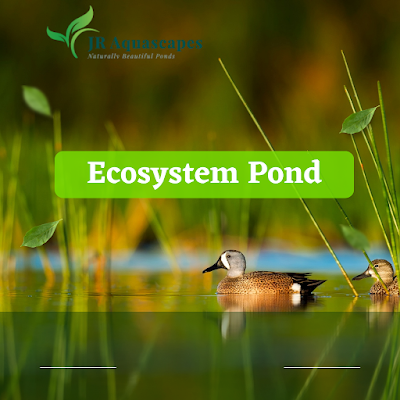The Science Behind Ecosystem Ponds: How They Maintain Natural Balance?
Ecological system ponds have become increasingly popular in recent years as an eco-friendly and sustainable alternative to traditional ornamental ponds. At their core, these ponds aim to recreate the natural balance and biodiversity found in nature.
This is achieved by incorporating various plants and animals that work together to create a thriving, self-sustaining miniature ecosystem. When designed and maintained properly, ecosystem ponds require less maintenance than regular ponds. They support a wide variety of aquatic life.
The Science Behind Natural Balance
These ponds maintain stability through the same ecological processes that govern natural environments. A key process is the nitrogen cycle, driven by nitrogen-fixing bacteria that live on surfaces within the pond.
These bacteria convert waste from fish and animals into plant-available ammonia and nitrates. It keeps the water fertilised while preventing a buildup of toxicity.
Another crucial process is the absorption of nutrients by aquatic plants. Plants need nitrogen and phosphorous to grow, which they absorb from fish waste and decomposition.
By drawing in these excess nutrients, plants prevent the unchecked growth of algae. This competition for nutrients maintains the balance between plants and algae.
Predator-prey relationships also regulate populations. Adding fish like goldfish and koi will control mosquito larvae and midges through direct predation.
Meanwhile, birds, bats and other pond predators will help curb populations of adult insects. This system of built-in pest control reduces the need for chemical intervention.
Oxygen exchange offers all of the pond’s lifeforms to thrive. Photosynthesising plants produce oxygen during the day, which fish and bacteria need to respire.
At night, plants switch to consuming oxygen. Having surface movement from pumps or fountains provides adequate oxygen circulation. This exchange allows the symbiotic relationship between plants and animals to flourish.
Mimicking Natural Ecosystems
The varied ensemble of plants and animals makes ecosystem ponds function similarly to natural freshwater ecosystems. Just like wild ponds, these ponds contain primary producers like:
- Plants
- Primary consumers like insects and fish and
- Secondary consumers.
Among them, secondary consumers are at the top of the food chain. This diverse web of life fills every niche in the miniature ecosystem.
With each species playing its ecological role, the pond finds a harmonious balance similar to its wild counterparts. For instance, the predator-prey relationship between dragonfly larvae and mosquito larvae automatically regulates populations.
Plants fertilise the water with nutrients while also filtering out excess pollution. Scavengers decompose waste from other organisms, recycling it back into the system.
This self-regulation reduces the need for human intervention and maintenance. An overpopulation of algae or mosquitoes is naturally brought back into balance without the use of chemicals. The pond finds equilibrium through the interactions between all its living components.
A vital aspect of this stability is the constant cycling of nutrients like nitrogen and phosphorous. Pants and animals produce waste or decay. Bacteria convert the organic matter back into usable nutrients for other life forms. This closed-loop system prevents the accumulation of excess nutrients or waste.
The biodiversity of ecosystem ponds also builds resilience against environmental stressors. With many species, if one population declines, there are other organisms available to fill its ecological role. This web of symbiotic relationships provides stability in the face of changes in temperature, sunlight or available resources.
By replicating this complexity and interconnectedness, these ponds can thrive with minimal maintenance required. The web of life is flexible and adaptable, maintaining natural equilibrium much like wild aquatic environments.
Design Considerations
When creating an ecosystem pond, its overall design must support the balance of nature. The first consideration is choosing plant and animal species adapted to the climate and pond conditions.
Native species are ideal, as they have evolved strategies to thrive in local environments. Introducing non-native or invasive species can disrupt the pond’s equilibrium.
The ratio of surface area to depth is also important. Shallow areas under 6 feet allow sunlight to reach submerged plants. Deeper zones over 6 feet provide habitats for fish. Incorporating this variation creates oxygenating, plant-rich littoral zones and cooler pelagic zones for animal life.
In terms of sizing, larger ponds are typically more stable. With a bigger volume of water, fluctuations in temperature and chemical composition are less drastic.
Larger ponds also support more biodiversity of organisms. As a general rule, ecosystem ponds should be at least 200-500 square feet for suitable stability, depending on climate.
Adding habitat features provides shelter and reproduction sites for wildlife. Partially submerged logs allow insects to emerge, while consolidated rocks make hideaways for juvenile fish.
Floating rafts give basking spots for frogs and turtles, and marginal plants create breeding areas for amphibians. Providing this diverse habitat complexity bolsters biodiversity.
Lastly, maintaining robust populations of beneficial bacteria is key to the nutrient cycling of ecosystem ponds. Adding gravel, rocky substrate and filtration media produces a surface area for colonies of nitrifying bacteria to thrive on. This healthy bacterial community drives the decomposition that sustains the pond’s fertility.
By taking these design considerations into account, ecosystem ponds promote self-regulation and require minimal care once established. It allows nature to find its balance.
Conclusion
Ecosystem ponds offer a chemical-free, sustainable alternative to ornamental ponds by replicating natural ecosystems. The synergy between aquatic plants, animals, bacteria and physical features makes the pond maintain ecological stability. Biodiversity and interconnected food webs help in this purpose.
These self-regulating ponds require far less maintenance than traditional designs. These ponds leverage ecological science and create ideal conditions for nature to find equilibrium.
With this, ecosystem ponds let people sustainably participate in aquatic environments. Their growing popularity highlights the possibilities of human-designed systems that live in balance with nature.




Comments
Post a Comment